British Army Uniform And Personal Arms WW1.
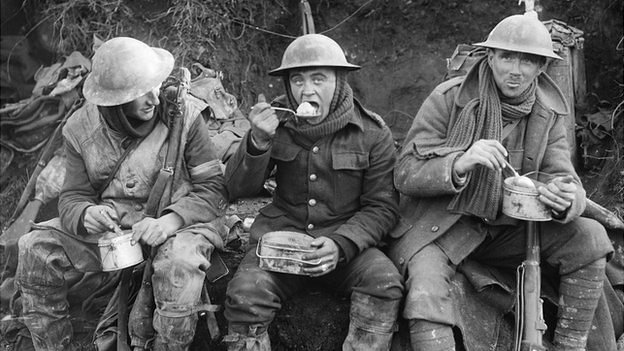
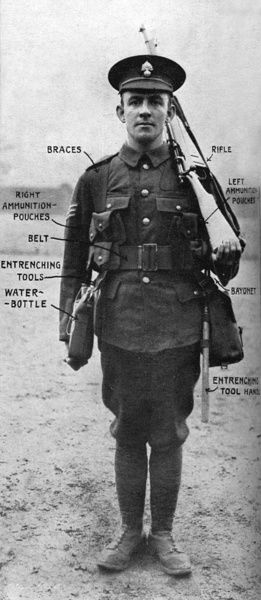
The British Army used a variety of standardised battle uniforms and weapons during World War I. According to the British official historian BrigadierJames E. Edmonds recorded in 1925, “The British Army of 1914 was the best trained best equipped and best organised British Army ever sent to war”. They were the only army to wear any form of a camouflage uniform; the value of Drab colour clothing was quickly recognised by the British Army, who introduced Khaki drill for Indian and colonial warfare from the mid-19th century on. Reforms following the Second Boer War, a darker khaki serge was adopted in 1902 for service dress in Britain itself. The British military authorities showed more foresight than their French counterparts, who retained highly visible blue coats and red trousers for active service until the final units received a new uniform over a year into World hug War I. The soldier was issued with the 1908 Pattern Webbing for carrying personal equipment, and he was armed with the Short Magazine Lee–Enfield rifle.
Uniform
The British soldier went to war in August 1914 wearing the 1902 Pattern Service Dress tunic and trousers. This was a thick woollen tunic, dyed khaki. There were two breast pockets for personal items and the soldier’s AB64 Pay Book, two smaller pockets for other items, and an internal pocket sewn under the right flap of the lower tunic where the First Field Dressing was kept. Rifle patches were sewn just above the breast pockets, to prevent wear from the webbing equipment and Enfield rifle. Shoulder straps were sewn on and fastened with brass buttons, with enough space for a brass regimental shoulder title. Rank insignia was sewn onto the upper tunic sleeves, while trade badges and Long Service and Good Conduct stripes were placed on the lower sleeves. A stiffened peak cap was worn, made of the same material, with a leather strap, brass fitting and secured with two small brass buttons. Puttees were worn around the ankles and calves, and ammunition boots with hobnail soles on the feet.
1908 Pattern webbing
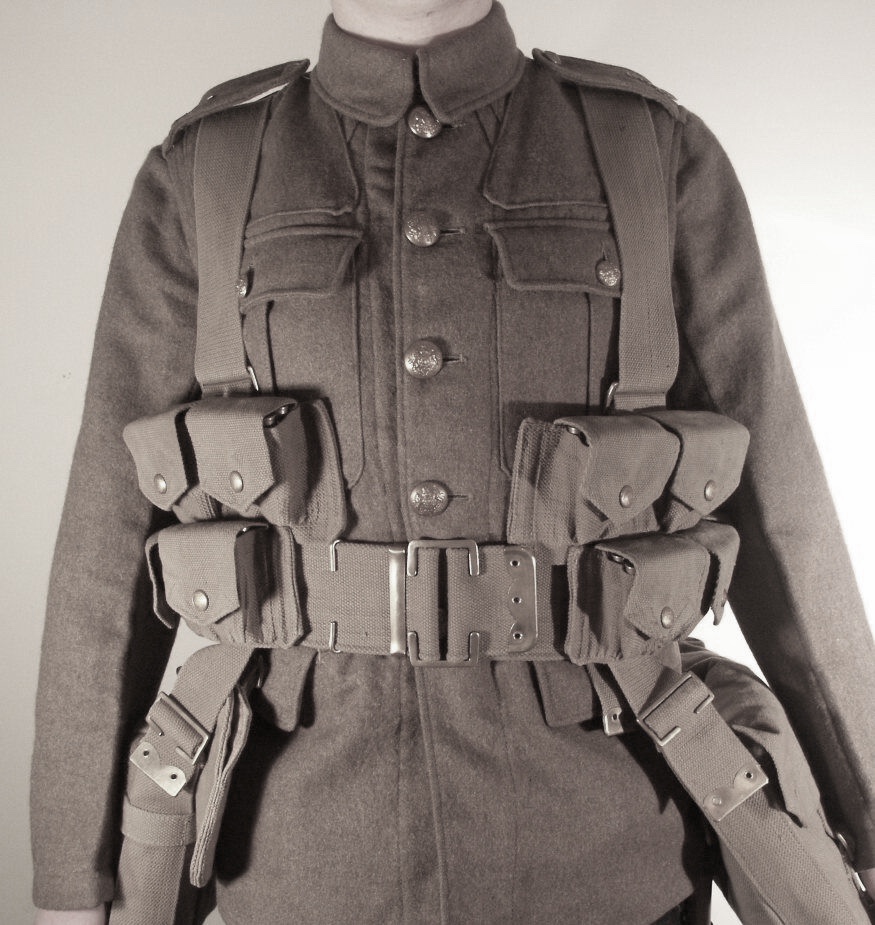
The British were the first European army to replace leather belts and pouches with webbing, a strong material made from woven cotton, which had been pioneered in the United States by the Mills Equipment Company. The 1908 Pattern Webbing equipment comprised a wide belt, left and right ammunition pouches which held 75 rounds each; left and right braces, a bayonet frog and attachment for the entrenching tool handle, an entrenching tool head in web cover, water bottle carrier, small haversack and large pack. A mess tin was worn attached to one of the packs, and was contained inside a cloth buff-coloured khaki cover. Inside the haversack were personal items, a knife, and, when on Active Service, unused portions of the daily ration. The large pack could sometimes be used to house some of these items, but was normally kept for carrying the soldier’s Greatcoat and or a blanket. The full set of 1908 webbing could weigh over 70 pounds (32 kg).
1903 Bandolier equipment
The British personal equipment used in the Second Boer War had been found to be deficient for a number of reasons, and the Bandolier Equipment was introduced as a stop-gap replacement. The equipment was made of brown leather and consisted of five 10-round ammunition pouches worn over one shoulder on a bandolier, with an associated waist belt and pouches, and a haversack and water bottle. It soon proved to be unsuitable for infantry use, but was used throughout the First World War by cavalry and other mounted troops. The cavalry version of the 1903 Equipment had a further four ammunition pouches on the bandolier, worn on the soldier’s back, giving a total of 90 rounds carried.
1914 Pattern leather equipment
On the outbreak of war, it became clear that the Mills Equipment Company would be quite unable to keep up with the sudden demand for webbing. Therefore, a version of the 1908 equipment was designed to be made in leather, as both Britain and the USA had large leather working industries with excess capacity. The leather was coloured with either a brown or khaki finish, and the packs and haversacks were made from canvas. It was originally intended that the leather equipment would be used by units in training or on home service, and that it would be exchanged for webbing before going on active service. However, in practice, reinforcement drafts and sometimes whole battalions would arrive at the front line still with their leather equipment.
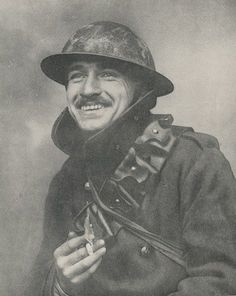
The Brodie helmet
The first delivery of a protective steel helmet (the Brodie helmet) to the British Army was in 1915. Initially there were far from enough helmets to equip every man, so they were designated as “trench stores”, to be kept in the front line and used by each unit that occupied the sector. It was not until the summer of 1916, when the first 1 million helmets had been produced, that they could be generally issued.
The helmet reduced casualties but was criticised by General Herbert Plumer on the grounds that it was too shallow, too reflective; its rim was too sharp, and its lining was too slippery. These criticisms were addressed in the Mark I model helmet of 1916 which had a separate folded rim, a two-part liner, and matte khaki paint finished with sand, sawdust, or crushed cork to give a dull, non-reflective appearance.
Short magazine Lee Enfield MkIII

The Lee–Enfield rifle, the SMLE Mk III, was introduced on 26 January 1907, along with a Pattern 1907 bayonet (P’07) and featured a simplified rear sight arrangement and a fixed, rather than a bolt-head-mounted sliding, charger guide. The fast-operating Lee bolt-action and large magazine capacity enabled a trained rifleman to fire 20 to 30 aimed rounds a minute, making the Lee–Enfield the fastest military bolt-action rifle of the day. World War I accounts tell of British troops repelling German attackers who subsequently reported that they had encountered machine guns, when in fact it was simply a group of trained riflemen armed with SMLE Mk III rifles. During the war, the standard SMLE Mk III was found to be too complicated to manufacture (an SMLE Mk III rifle cost the British Government £3/15/-), and demand was outstripping supply, so in late 1915 the Mk III* was introduced.
The Revolver
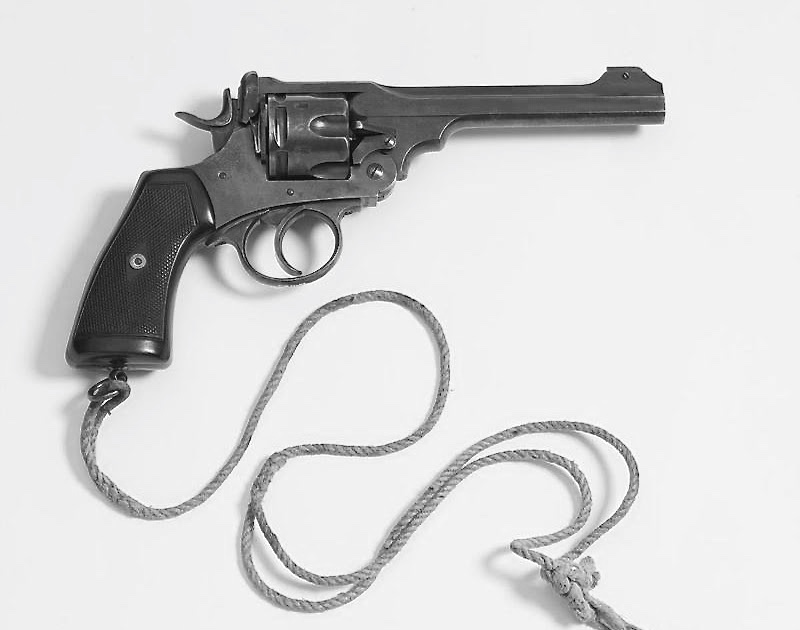
The standard-issue Webley revolver at the outbreak of World War I was the Webley Mk V (adopted 9 December 1913), but there were considerably more Mk IV revolvers in service in 1914, as the initial order for 20,000 Mk V revolvers had not been completed when hostilities began. On 24 May 1915, the Webley Mk VI was adopted as the standard sidearm for British troops and remained so for the duration of World War I, being issued to officers, airmen, naval crews, boarding parties, trench raiders, machine-gun teams, and tankcrews. The Mk VI proved to be a very reliable and hardy weapon, well suited to the mud and adverse conditions of trench warfare, and several accessories were developed for the Mk VI, including a bayonet (made from a converted French Pritchard bayonet), a speedloader device (“Prideaux Device”), and a stock allowing for the revolver to be converted into a carbine. As officers were required to purchase their own pistols, some opted for other weapons such as the Webley–Fosbery Automatic Revolver, but it was never service issue.
Extracted for light reading from Wikipedia

